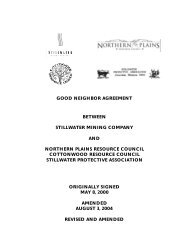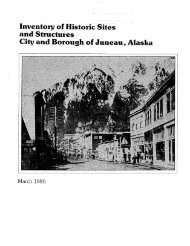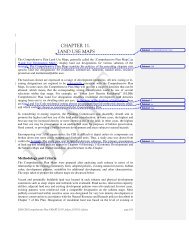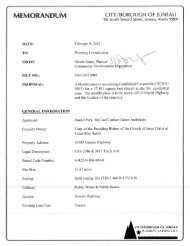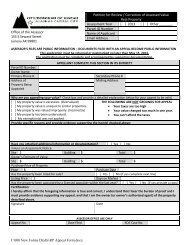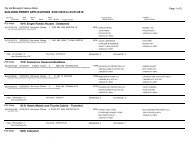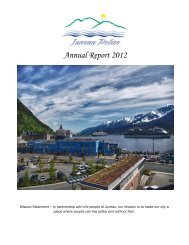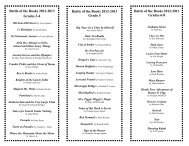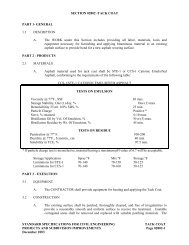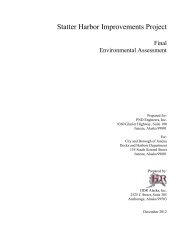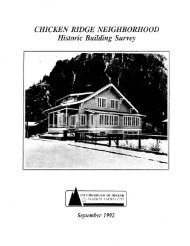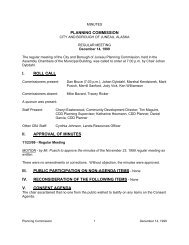HISTORIC CEMETERIES - City and Borough of Juneau
HISTORIC CEMETERIES - City and Borough of Juneau
HISTORIC CEMETERIES - City and Borough of Juneau
Create successful ePaper yourself
Turn your PDF publications into a flip-book with our unique Google optimized e-Paper software.
future tasks to be pursued. In 1990, the department revised its strategy, reviewed its<br />
accomplishments <strong>and</strong> identified new tasks for the next four years. The goal for·the historic<br />
preservation program remained the same:<br />
The Department <strong>of</strong> Community Development will gather<br />
information on the historical development <strong>of</strong> the<br />
<strong>Juneau</strong>/Douglas area. This resource basewill serve as an aid<br />
in long-range planning for growth <strong>and</strong> development<br />
in the <strong>City</strong> <strong>and</strong> <strong>Borough</strong> <strong>of</strong> <strong>Juneau</strong>.<br />
One<strong>of</strong> the priorities identified was the need for recognition <strong>and</strong> survey <strong>of</strong> potential historic<br />
districts. As a means <strong>of</strong> identifying areas for study <strong>and</strong> for devising betterstrategies for<br />
management, the department developed its historic neighborhood concept. Areas <strong>of</strong> potential<br />
significance are identified which can be described as cohesive architectural <strong>and</strong>/or historical<br />
entities. Boundaries are based on geography, topography, historic uses, <strong>and</strong> resource types.<br />
These areas are surveyed <strong>and</strong> the. information collected through these surveys identifies<br />
districts <strong>of</strong> historic. <strong>and</strong>/or architectural significance which, when placed in regional <strong>and</strong><br />
community contexts, allows for planning in areas relating to the preservation <strong>of</strong> these cultural<br />
resources. Specifically, these surveys allowthe Community Development Department to<br />
identify architectural <strong>and</strong>/or historic districts which are eligible for nomination to the National<br />
Register <strong>of</strong>Historic Places.<br />
The survey <strong>and</strong> inventory <strong>of</strong> the Douglas Cemeteries is a departure from the practice <strong>of</strong><br />
evaluating historic buildings. The cemeteries are "neighborhoods" in a sense in that they have<br />
common attributes <strong>and</strong> <strong>of</strong>ten common styles <strong>of</strong> headstones, families are <strong>of</strong>ten grouped<br />
together, <strong>and</strong> most wereplanned <strong>and</strong> laid out with a sense <strong>of</strong> organization.<br />
Description <strong>of</strong> Survey Area<br />
In 1994, the CBJ Community Development Department applied for <strong>and</strong> received a Historic<br />
Preservation Matching Fund Grant to Survey <strong>and</strong> Inventory the Historic Cemeteries <strong>of</strong><br />
Douglas, Alaska. The survey area encompassed three non contiguous cemetery sites known<br />
generally as the "Catholic Cemetery", "Eagles Cemetery", <strong>and</strong> the Douglas Indian Cemetery.<br />
Two <strong>of</strong> the cemeteries are located across Douglas Highway from each other. The third, the<br />
Douglas Indian Cemetery, is located about a mile <strong>and</strong> a half down the road. Once research<br />
began it was uncovered that two <strong>of</strong> the cemeteries were actually made up <strong>of</strong> a grouping <strong>of</strong><br />
smaller cemeteries. The "Catholic Cemetery" includes the Catholic Cemetery, the Odd<br />
Fellows Cemetery, the Masons Cemetery, the Native Cemetery, the Asian Cemetery, <strong>and</strong> the<br />
Russian Orthodox Cemetery. The "Eagles Cemetery" is made up <strong>of</strong> the <strong>City</strong> Cemetery, the<br />
Eagles Cemetery, <strong>and</strong> the Servian Cemetery. All grave markers within the cemetery<br />
boundaries were surveyed <strong>and</strong> an inventory <strong>of</strong> burial records was compiled.<br />
Survey Methodology<br />
The survey <strong>and</strong> inventory <strong>of</strong> these historic cemeteries involved literature research, field<br />
investigation, <strong>and</strong> documentation. The search for information included research in the Tax<br />
Inventory <strong>and</strong> Survey <strong>of</strong>Historic Cemeteries in Douglas, Alaska Page 4



